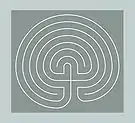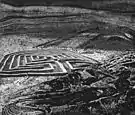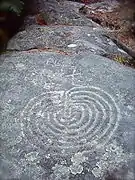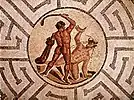قصر التيه
قصر التيه أو المتاهة (لغة يونانية λαβύρινθος labyrinthos، (بالإنجليزية: Labyrinth)) الأرض التي يتوه فيها السالك ولايكاد يعرف فيها طريقا. ويراد بها في الأساطير مبنى التّيه ذو الممرات الفرعية المعقدة الذي بناه ديدالوس للملك مينوس ملك كريت، حسب الأسطورة الإغريقية، وأراد مينوس أن يجعل منها سجنًا للوحش الذي يسمى المينطور. إذ كان يضحَّى بسبعة من شباب أثينا، وسبع عذارى لهذا الوحش كل سنة.



ذهب ثيسيوس ابن الملك الأثيني إلى تلك المتاهة وقتل المينوتور، وتمكَّن من شق طريقه إلى الخارج خلال الممرات الفرعية الملتوية. وكانت أريادني ابنة مينوس قد أعطت ثيسيوس كرة من الخيوط، لينشرها في طريقه إلى الداخل، ثم يتعقب هذه الخيوط ويسير باتجاهها عند هَرَبه.
وقد اكتشف علماء الآثار قصرًا ربما كان هو مكان المتاهة الكريتية. إذ تم اكتشافه في المدينة الكريتية كنوسوس ويحتوي المكان على ممرات وطرق فرعية عديدة ويشبه المتاهة الأسطورية. وعثر على فؤوس كثيرة ذات رؤوس مزدوجة في القصر. ويعتقد معظم العلماء أن كلمة متاهة كانت تعني في الإغريقية الفأس ذات الرأس المزدوج. وأصبحت تعني المكان الذي يحتوي على طرق وممرات عديدة معقدة. كما عثر علماء الآثار على بقايا متاهة كبيرة أخرى في مصر.
قصور التيه القديمة
يذكر پلني الأكبر في كتابه التاريخ الطبيعي أربع قصور تيه قديمة: قصر التيه الكريتي، قصر التيه المصري، قصر التيه اللمني وقصر التيه الإيطالي. وفي القرن التاسع عشر، تم اكتشاف بقايا قصر التيه على بعد "11 1/2 ميل من هرم الهوارة في محافظة الفيوم.".[1] توجد أبنية تحتوي على شبكة من الممرات والطرق الفرعية التي لا نهاية لها في بعض حدائق الترويح، وتسمَّى المتاهة، وتُستخدم لاختبار المهارة في حل المعضلة. إذ إن كثيرًا من الألعاب والتمارين المسلية تقوم أساسًا على فكرة المتاهة، وتستخدم أيضًا في التجارب لاختبار ردود الفعل عند الحيوانات.
المراجع
- Leonhard Schmitz, George Eden Marindin, Labyrinthus entry, in ويليام سميث (عالم) et al. (editors), Dictionary of Greek and Roman Antiquities, published 1890.
المصادر
- Hermann Kern, Through the Labyrinth, ed. Robert Ferré and Jeff Saward, Prestel, 2000, ISBN 3-7913-2144-7. (This is an English translation of Kern's original German monograph Labyrinthe published by Prestel in 1982.)
- Penelope Reed Doob, The Idea of the Labyrinth: from Classical Antiquity through the Middle Ages, Cornell University Press, 1992, ISBN 0-8014-2393-7.
- هيرودوت, تاريخ هيرودوتس, Newly translated and with an introduction by Aubrey de Sélincourt, Harmondsworth, England, دار بنجوين للنشر, 1965.
- كارولي كيريني, Dionysos: Archetypal Image of Indestructible Life, Princeton University Press, 1976.
- Helmut Jaskolski, The Labyrinth: Symbol of Fear, Rebirth and Liberation, Shambala, 1997.
- Adrian Fisher & Georg Gerster, The Art of the Maze, Weidenfeld & Nicolson, 1990. ISBN 0-297-83027-9.
- Jeff Saward, Labyrinths and Mazes, Gaia Books Ltd, 2003, ISBN 1-85675-183-X.
- Jeff Saward, Magical Paths, Mitchell Beazley, 2002, ISBN 1-84000-573-4.
- W.H. Matthews, Mazes and Labyrinths: Their History and Development, Longmans, Green & Co., 1922. Includes bibliography. Dover Publications reprint, 1970, ISBN 0-486-22614-X.
- Andrew Stewart, One Hundred Greek Sculptors: Their Careers and Extant Works.
- Henning Eichberg, 2005: "Racing in the labyrinth? About some inner contradictions of running." In: Athletics, Society & Identity. Imeros, Journal for Culture and Technology, 5:1) Athen: Foundation of the Hellenic World, 169-192.
- Edward Hays, The Lenten Labyrinth: Daily Reflections for the Journey of Lent, Forest of Peace Publishing, 1994.
وصلات خارجية
- Labyrinthos maintained by Jeff Saward
- The Labyrinth Society
- Through Mazes to Mathematics Exposition by Tony Phillips, SUNY
- Maze classification Extensive classification of labyrinths and algorithms to solve them.
- IRRGARTENWELT.DE Lars O. Heintel's collection of handdrawn labyrinths and mazes
- Labyrinthe in Deutschland Website (in German) with diagrams and photos of virtually all the public labyrinths in Germany.
- Mystery Labyrinth German website (in German and English) with descriptions, animations, links, and especially photos of (mostly European) labyrinths.
- British turf labyrinths by Marilyn Clark. Photos and descriptions of the surviving historical turf mazes in Britain.
- Jo Edkins's Maze Page An early website providing a clear overview of the territory and suggestions for further study.
- "Die Kretische Labyrinth-Höhle" by Thomas M. Waldmann, rev. 2009 (in German, English, French, and Greek). Description of a labyrinthine artificial cave system near Gortyn, Crete, widely considered (before the discovery of Knossos) the original labyrinth on Crete. (Presentation somewhat amateurish – including <blink> tags – but many detailed photos.)
- SpiralZoom.com an educational website about the science of pattern formation, spirals in nature, and spirals in the mythic imagination & labyrinths.
- Guerrilla Labyrinths Light-weight site by David Brazzeal, who creates "occasional" labyrinths.
- The Geometry of History A short overview by Tessa Morrison, U. of Newcastle, Australia.
- Labyrinth- A Sacred Walk The Ursulines Sisters construct a Labyrinth - Canfield, Oh
- بوابة عمارة
- بوابة ألعاب تقمص أدوار
- بوابة ألعاب
 صور وملفات صوتية من كومنز
صور وملفات صوتية من كومنز
